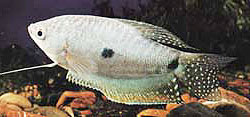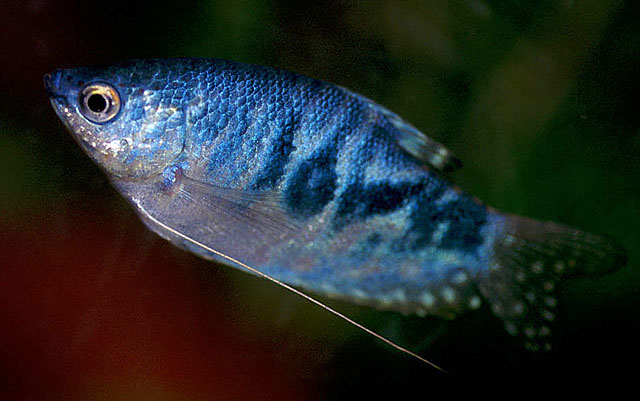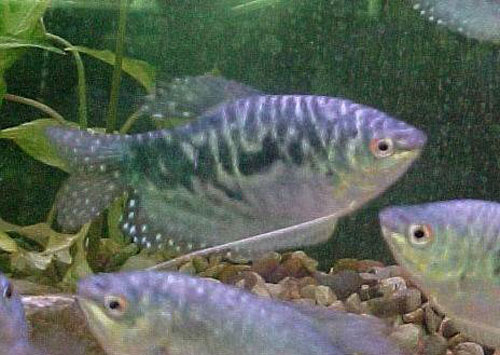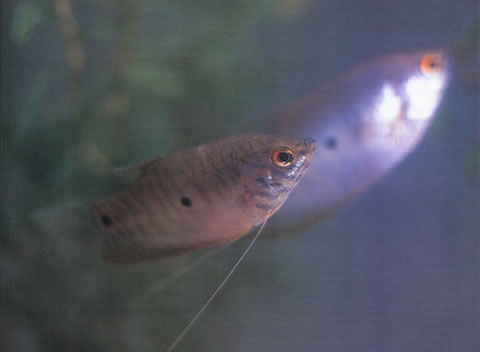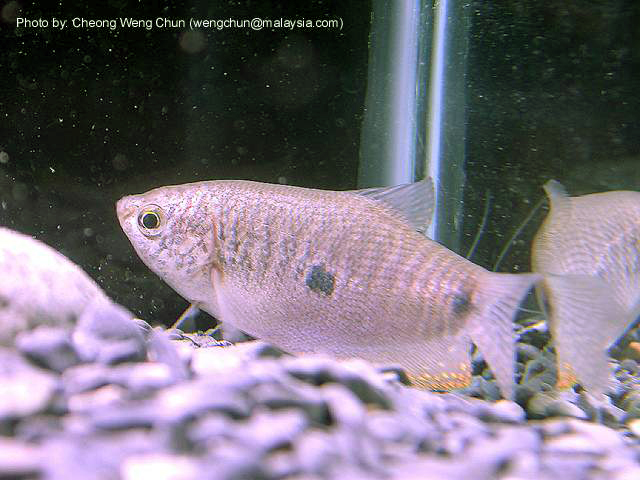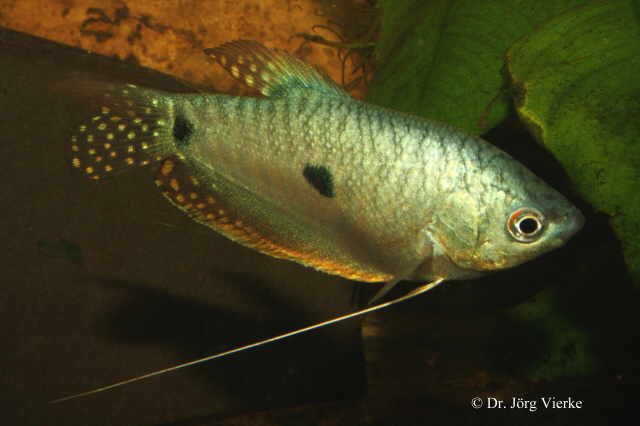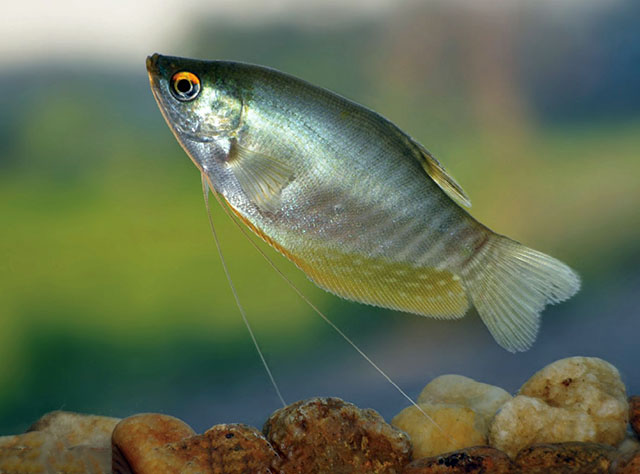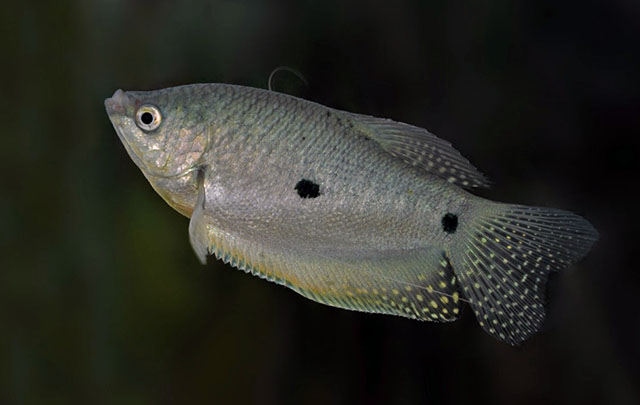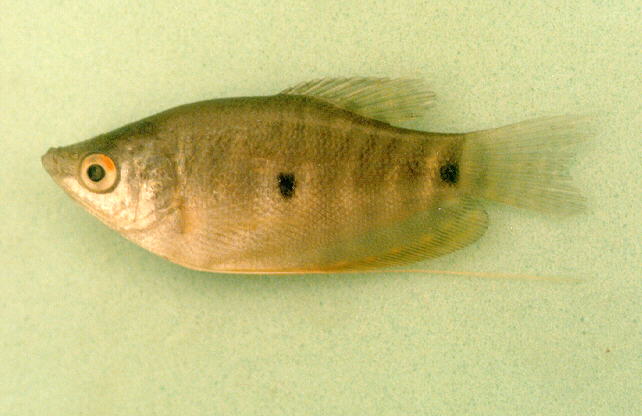Trichopodus
trichopterus
(Pallas,
1770)
Three spot gourami
View all media / Upload your photos and videos
Expand all
Classification / Names
Teleostei (teleosts) > Anabantiformes (Gouramies, snakeheads) >
Osphronemidae (Gouramies)
> Trichogastrinae
More on author:
Pallas.
Environment / milieu / depth range / climate zone / distribution range
Distribution
Size / Weight / Age
Short description
Dorsal spines (total): 6 - 8; Dorsal soft rays (total): 7 - 10; Anal spines: 9 - 12; Anal soft rays: 30 - 38. Color in life brown; shoulders with irregular dark marks, yellowish on opercles and thorax; median fins and pectorals brown, ventrals yellowish. Mouth very small, very oblique, upper jaw vertical and somewhat protractile, lower jaw prominent. Scales of moderate size, irregularly arranged. Lateral line curved, irregular. Caudal fin slightly emarginate or truncate (Ref. 4792). With 8-9 dorsal-fin branched rays; 33-38 branched anal-fin rays; black spot in middle of side and at caudal-fin base (Ref. 12693). Body with numerous narrow irregular oblique bars (Ref. 43281).
Biology
Lives in lowland wetlands (Ref. 57235). Found in marshes, swamps and canals (Ref. 43281). Inhabits shallow sluggish or standing-water with a lot of aquatic vegetation. Occurs in seasonally flooded forests throughout the middle and lower Mekong (Ref. 12693). Undertakes lateral migrations from the Mekong mainstream, or other permanent water bodies, to flooded areas during the flood season and returns to the permanent water bodies at the onset of the dry season (Ref. 37770). An air-breathing species (Ref. 118402). Feeds on zooplankton, crustaceans and insect larvae. Processed into salted, dried fish in Java (Ref. 4929). Also marketed fresh and commonly seen in the aquarium fish trade (Ref. 12693). Aquarium keeping: minimum aquarium size 100 cm (Ref. 51539).
Life cycle and mating behavior
Main reference
Rainboth, W.J. 1996 Fishes of the Cambodian Mekong. FAO species identification field guide for fishery purposes. FAO, Rome, 265 p. (Ref. 12693)
IUCN Red List Status (Ref. 125652)
Least Concern (LC); date assessed: January 21 2019
CITES (Ref. 131153)
Not Evaluated
CMS (Ref. 116361)
Not Evaluated
Threat to humans
Harmless
More information
- Countries
- FAO areas
- Ecosystems
- Occurrences
- Introductions
- Stocks
- Ecology
- Diet
- Food items
- Food consumption
- Ration
- Common names
- Synonyms
- Metabolism
- Predators
- Ecotoxicology
- Reproduction
- Maturity
- Spawning
- Spawning aggregation
- Fecundity
- Eggs
- Egg development
- Age/Size
- Growth
- Length-weight
- Length-length
- Length-frequencies
- Morphometrics
- Morphology
- Larvae
- Larval dynamics
- Recruitment
- Abundance
- References
- Aquaculture
- Aquaculture profile
- Strains
- Genetics
- Allele frequencies
- Heritability
- Diseases
- Processing
- Mass conversion
- Vision
- Pictures
- Stamps, Coins Misc.
- Sounds
- Ciguatera
- Speed
- Swim. type
- Gill area
- Otoliths
- Brains
Estimates based on models
Phylogenetic diversity index (Ref. 82804): PD50 = 0.5156 [Uniqueness, from 0.5 = low to 2.0 = high].
Bayesian length-weight: a=0.02089 (0.01260 - 0.03464), b=3.02 (2.88 - 3.16), in cm total length, based on LWR estimates for this species & (Sub)family-body (Ref. 93245).
Trophic level (Ref. 69278): 2.7 ±0.2 se; Based on food items.
Resilience (Ref. 120179): High, minimum population doubling time less than 15 months (tm<1; multiple spawning per year;).
Fishing vulnerability (Ref. 59153): Low vulnerability (10 of 100).
Price category (Ref. 80766): Unknown.
Nutrients (Ref. 124155): Calcium = 77.3 [33.3, 362.6] mg/100g; Iron = 1.35 [0.58, 2.96] mg/100g; Protein = 18.2 [16.6, 19.7] %; Omega3 = 0.252 [0.088, 0.716] g/100g; Selenium = 36.2 [13.7, 89.5] μg/100g; VitaminA = 32.8 [8.3, 136.7] μg/100g; Zinc = 3.05 [1.47, 6.01] mg/100g (wet weight);

